Beer › Ashurnasirpal II » Ancient origins
Articles and Definitions › Contents
- Beer › Antique Origins
- Ashurnasirpal II › Who Was
Ancient civilizations › Historical and archaeological sites
Beer › Antique Origins
Definition and Origins
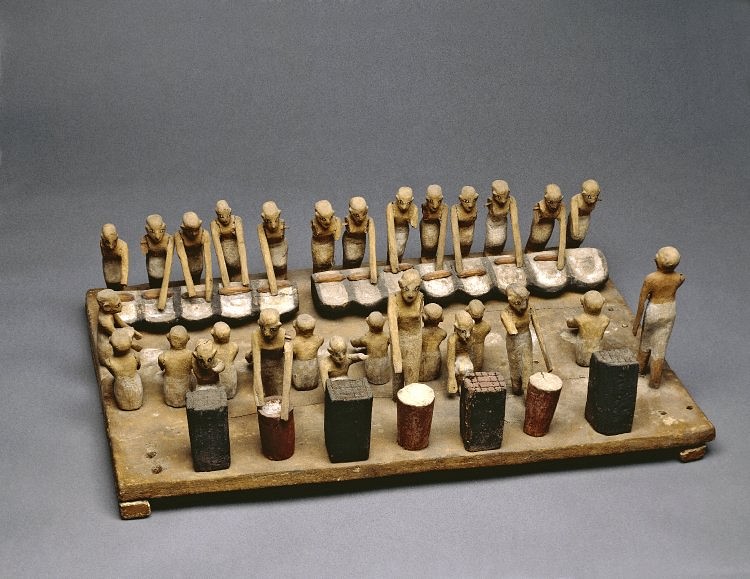
Beer is one of the oldest intoxicating beverages consumed by human beings. Even a cursory survey of history makes clear that, after human beings have taken care of the essential needs of food, shelter, and rudimentary laws for the community, their next immediate concern is developing intoxicants. Evidence of early beer brewing has been confirmed by finds at the Sumerian settlement of Godin Tepe in modern-day Iran going back to between 3500-3100 BCE but intoxicants had already become an integral aspect of daily human life long before. Scholar Jean Bottero writes:
In ancient Mesopotamia, among the oldest `civilized people' in the world, alchoholic beverages were part of the festivities as soon as a simple repast bordered on a feast. Although beer, brewed chiefly from a barley base, remained the `national drink', wine was not uncommon. (84)
Although wine was consumed in Mesopotamia, it never reached the level of popularity that beer maintained for thousands of years. Sumerians loved beer so much they ascribed the creation of it to the gods and beer plays a prominent role in many of the Sumerian myths, among them, Inanna and the God of Wisdom and The Epic of Gilgamesh. The Sumerian Hymn to Ninkasi, written down in 1800 BCE but understood to be much older, is both a praise song to the Sumerian goddess of beer and a recipe for brewing.
MESOPOTAMIAN BEER WAS A THICK, PORRIDGE-LIKE DRINK CONSUMED THROUGH A STRAW & WAS MADE FROM BIPPAR (BARLEY BREAD).
Brewers were female, most likely priestesses of Ninkasi, and early on beer was brewed by women in the home as a supplement to meals. The beer was a thick, porridge-like drink consumed through a straw and was made from bippar (barley bread) which was baked twice and allowed to ferment in a vat. By the year 2050 BCE beer brewing had become commercialized as evidenced by the famous Alulu beer receipt from the city of Ur dated to that time.
THE ORIGIN & DEVELOPMENT OF BEER
It is thought that the craft of brewing beer began in domestic kitchens when grains used for baking bread were left out unattended and began to ferment. Scholars Jeremy Black and Anthony Green, to name only one authority on the subject, write, “alcoholic beverages probably resulted from an accidental discovery during the early hunter-gatherer stage of human prehistory” (Gods,28). While this theory has long been accepted, scholar Stephen Bertman advances another and discusses the long-standing popularity of the drink:
Though bread was basic to the Mesopotamian diet, botanist Jonathan D. Sauer has suggested the making of it may not have been the original incentive for raising barley. Instead, he has argued, the real incentive was beer, first discovered when kernels of barley were found sprouting and fermenting in storage. Whether or not Sauer is right, beer soon became the ancient Mesopotamian's favorite drink. As a Sumerian proverb has it: "He who does not know beer, does not know good." The Babylonians had some 70 varieties, and beer was enjoyed by both gods and humans who, as art shows, drank it from long straws to avoid the barley hulls that tended to float to the surface. (292)

Lapis Lazuli Cylinder Seal of Queen Puabi
The scholar Max Nelson also rejects the claim that brewing beer was discovered accidentally, writing :
Fruits often naturally ferment through the actions of wild yeast and the resultant alcoholic mixtures are often sought out and enjoyed by animals. Pre-agricultural humans in various areas from the Neolithic period on surely similarly sought out such fermenting fruits and probably even collected wild fruits in the hopes that they would have an interesting physical effect (that is, be intoxicating) if left in the open air. (9)
Beer became popular, not only because of the taste and its effects, but because it was healthier to drink than the water of the region. Scholar Paul Kriwaczek details how the waste disposal systems of the cities of Mesopotamia were intricately designed to deposit human and animal waste outside the city walls, and yet that was precisely where the water supply was usually located. Kriwaczek notes how this was "a magnificent engineering achievement but a potential disaster for public health" (83).The best waters were far from the cities but nearby streams could be tapped for water to make beer which was safer to drink because of the fermenting process which involved boiling the water. Kriwaczek continues:
If the watercourses were unsafe, boreholes and wells were no more providers of drinking water, as the saline water-table was too close to the surface. Beer therefore, sterilized by its weak alcohol content, was the safest drink, just as in the western world, as late as Victorian times, it was served at every meal, even in hospitals and orphanages. In ancient Sumer, beer also constituted a proportion of the wages paid to those who had to serve others for their living. (83)
Beer became the drink of choice throughout the region and especially so once it developed into a commercial enterprise. At this point, it seems, the business was taken over by men who recognized how lucrative it could be and women - the traditional brewers - continued on under their supervision. The brew was all hand-crafted, of course, but as it gained in popularity was made in greater quantities and this led to the development of larger-scale breweries. Scholar Gwendolyn Leick comments:
Beer was produced mainly from barley. From the pounded grain, cakes were molded and baked for a short time.These were pounded again, mixed with water, and brought to fermentation. Then the pulp was filtered and the beer stored in large jars. Mesopotamian beer could be kept only for a short time and had to be consumed fresh.The cuneiform texts mention different kinds of beer, such as "strong beer", "fine beer", and "dark beer". Other sorts were produced from emmer or sesame, as well as dates in the Neo-Babylonian Period and later. (33)
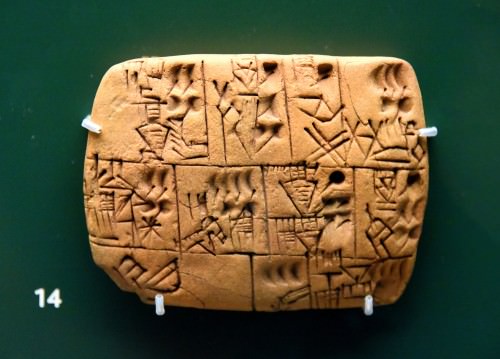
Mesopotamian Beer Rations Tablet
The gods were thought to have given beer to humanity and so beer was offered back to them in sacrifice at the temples throughout Mesopotamia. As noted, it was also used to pay wages and was consumed readily at religious festivals, celebrations, and funeral ceremonies. Beer was associated with good times as a drink which made one's heart feel light and allowed one to forget one's problems.
In The Epic of Gilgamesh, for example, the hero, distraught over the death of his friend, sets out on a quest for immortality and the meaning of life. In his travels, he meets the barmaid Siduri who suggests he leave off such lofty aspirations and simply enjoy life while he lives; in short, she tells him to relax and have a beer. Beer was widely enjoyed for a variety of reasons and under virtually every sort of circumstance. Black and Green write:
That commercialized social drinking, not for religious or medicinal purposes, was common by at least the early second millennium BC is attested by the laws of Hammurabi of Babylon regulating public houses. (Gods, 28)
Although the Sumerians had first developed the craft of brewing, the Babylonians took the process further and regulated how it was brewed, served, and even who could sell it. A priestess who had been consecrated to a deity, for example, was allowed to drink as much beer as she pleased privately but was prohibited from opening a tavern, serving beer, or entering a tavern to drink publicly like a common woman.
HAMMURABI'S CODE THREATENS DEATH BY DROWNING FOR ANY WOMAN TENDING BAR WHO POURS A `SHORT MEASURE' OF BEER FOR A CUSTOMER.
As with the brewing process itself, the first bartenders were women as the Code of Hammurabi makes clear. Among other regulations, Hammurabi's code threatens death by drowning for any woman tending bar who pours a `short measure' of beer for a customer; meaning anyone who does not fill the customer's vessel in accordance with the price paid.
BEER TRAVELS THE WORLD
Through trade, beer travelled to Egypt where the people embraced the brew eagerly. Egyptians loved their beer as much as the Mesopotamians did and breweries grew up all around Egypt. As in Mesopotamia, women were the first brewers and beer was closely associated with the goddess Hathor at Dendera at an early stage. Scholar Richard H. Wilkinson writes:
Hathor was associated with alcoholic beverages which seem to have been used extensively in her festivals, and the image of the goddess is often found on vessels made to contain wine and beer. Hathor was thus known as the mistress of drunkenness, of song, and of myrrh, and it is certainly likely that these qualities increased the goddess's popularity from Old Kingdom times and ensured her persistence throughout the rest of Egypt's history. (143)
Although Hathor encouraged people to freely express their joy in life through drink, it should be noted that drinking to excess was only appropriate under certain conditions. Neither Hathor nor any of the other Egyptian deities smiled upon drunk workers or those who abused alcohol to another's detriment. The universal principle of ma'at (harmony and balance) allowed for excessive drinking but always in balance with the rest of one's daily responsibilities, one's family, and the larger community.
Hathor was not the primary goddess of beer, however; the Egyptian goddess of beer was Tenenit (from one of the Egyptian words for beer, tenemu ) and it was thought the art of brewing was first taught to her by the great god Osiris himself. Like Ninkasi in Sumer, Tenenit brewed her beer from the finest ingredients and oversaw every aspect of its creation.
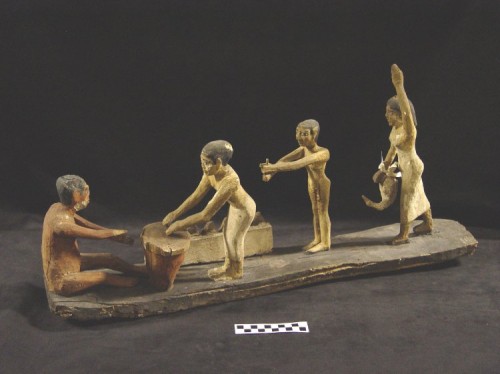
Beer Brewing in Ancient Egypt
The final result of her efforts was a brew which was enjoyed throughout the land in a number of different varieties. Workers at the Giza plateau received beer rations three times a day and prescriptions for various ailments included the use of beer (over 100 recipes for medicines included the drink). As in Mesopotamia, beer was thought to be healthier than drinking water and was consumed by Egyptians of all ages, the youngest to the oldest.
From Egypt, beer traveled to Greece (as evidenced by the similarity of another of the Egyptian's word for beer, zytum and the ancient Greek for the beverage, zythos ). The Greeks, however, as the Romans after them, favored strong wine over beer and considered the grainy brew an inferior drink of barbarians. The Roman Emperor Julian even composed a poem extolling the virtues of wine as a nectar while noting that beer smelled like a goat. That the Romans did brew beer, however, is evidenced by finds at the Roman outpost in Regensburg, Germany - founded in 179 CE by Marcus Aurelius as Casta Regina- as well as at Trier and other sites.
THE FALL & RISE OF BEER
As the Roman Empire spread, so naturally did Roman culture and tastes. Since the Romans favored wine over beer, beer was considered a distasteful “barbarian beverage” as compared with the cultivated and higher-class drink of wine. Even so, it seems it was primarily the Celts who were first responsible for wine's preferential status over beer as they also considered beer an unfit drink for a man. Nelson writes:
Beer was thought to be an inferior type of intoxicant since it was (at least often) affected by the corrupting power of yeast and was naturally a `cold' and hence effeminate substance while wine was thought to be unaffected by yeast and to be rather a `hot' and hence manly substance. (115-116)
The Gauls were “addicted to the wine imported by Italian merchants which they drank unmixed [with water] and in immoderate amounts to the point of falling into stupors” and also that they were so enamored of wine that they would “exchange a slave for one jar of Italian wine” (Nelson, 48-49). However poorly beer was viewed by the prevailing elite, though, their attitude did nothing to stop people from brewing the drink.

Urartian Beer Pitchers
As Nelson makes clear throughout his work, The Barbarian's Beverage: A History of Beer in Ancient Europe, the brew recognized in the modern day as `beer' developed in Germany and their brewing techniques then influenced further development throughout Europe. The Germans were brewing beer as early as 800 BCE and their early methods mirrored those of the ancient Sumerians in regard to purity of the brew but with the important addition of hops. Women were also the first brewers in Germany and beer was made from only fresh water, heated, and the best grains. The tradition continued down into the Christian era when monks took up the craft of brewing and sold beer from their monasteries.
Beer was still considered a divine gift, now given by the Christian god, and the evils which might arise from drunkenness was ascribed to the devil (Nelson, 87). The biblical injunction to refrain from drunkenness (Ephesians 5:18) was not thought to apply to the drink itself but rather to overindulgence which opened the door for darker powers to enter one's life rather than one being filled with the Holy Spirit sent from God. This view of beer is similar to that of the people of ancient Mesopotamia who blamed an individual for over-indulgence in drink, and the attendant problems which might arise, but never the drink itself.
By 770 CE, the Christian champion Charlemagne the Great was appointing brewers in France and, like the Babylonians before him, regulated the production, sale, and use of it. Beer was still understood to be healthier to drink than water because of the brewing process and continued to be associated with a divine origin; its popularity also continued undiminished. The Finnish epic, The Kalevala (written in the 17th century CE, but based on much older tales) devotes more lines to beer than to the creation of the world and praises the effects of beer in such a way that they would easily be recognizable to anyone from ancient Sumeria to a modern-day drinker.
Brewers continued to enjoy a special status in their communities until the 19th and 20th centuries CE when temperance groups gained political power in the United States and areas of Europe and were able to effect prohibition to greater or lesser degrees. Even so, the long-established popularity of intoxicants among human beings could not be suppressed by legislation and all the acts of all the governing bodies would not stop brewers and vintners from rising again. In the modern day, beer is as lucrative a commercial venture as it was in the ancient world and the drink retains its popularity on an international scale.Whether an individual is experiencing good or bad times, beer continues to enjoy the same high status it did in ancient Mesopotamia: the drink which makes one's heart feel light.
Ashurnasirpal II › Who Was
Definition and Origins
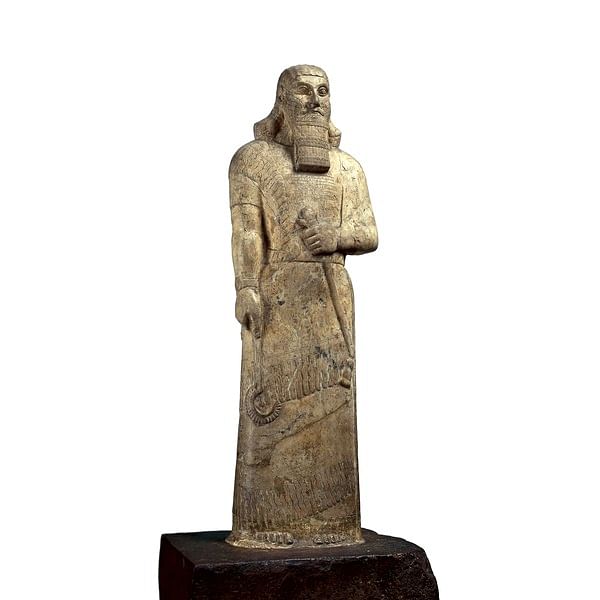
Ashurnasirpal II (reigned 884-859 BCE) was the third king of the Neo-Assyrian Empire. His father was Tukulti- Ninurta II (reigned (891-884 BCE) whose military campaigns throughout the region provided his son with a sizeable empire and the resources to equip a formidable army. Ashurnasirpal II is known for his ruthless military conquests and the consolidation of the Assyrian Empire, but he is probably most famous for his grand palace at Kalhu (also known as Caleh and Nimrud in modern-day Iraq), whose wall reliefs depicting his military successes (and many victims) are on display in museums around the world in the modern day. In addition to the palace itself, he is also known for throwing one of the most impressive parties in history to inaugurate his new city of Kalhu: he hosted over 69,000 people during a ten day festival. The menu for this party still survives in the present day. He reigned for 25 years and was succeeded by his son, Shalmaneser III, who reigned from 859-824 BCE.
EARLY REIGN & MILITARY CAMPAIGNS
Ashurnasirpal II's grandfather was Adad-Nirari II (reigned 912-891 BCE), generally considered the first king of the Neo-Assyrian Empire, who initiated the revitalization of the government and the military. His diplomatic skills, especially his treaty with Babylon, ensured stability in the empire, while his military conquests enriched the treasury and expanded the empire's borders. His son continued his policies so that, by the time Ashurnasirpal II came to the throne, he had at his disposal a well-equipped fighting force and considerable resources. He put both of these to use almost at once. He was not so much interested in expansion of the empire as in securing it against invasion from without or rebellion from within. He also was required, as an Assyrian king, to combat the forces of chaos and maintain order. The historian Marc Van De Mieroop writes, “The king, as representative of the god Assur, represented order. Wherever he was in control, there was peace, tranquility, and justice, and where he did not rule there was chaos. The king's duty to bring order to the entire world was the justification for military expansion” (260). While Ashurnasirpal may not have considered expansion a priority, he certainly took order in his realm very seriously and would not tolerate insubordination or revolt.
IN THE UNDERSTANDING OF THE PEOPLE OF THE NEAR EAST AT THAT TIME, ASHURNASIRPAL II REALLY WAS “KING OF THE WORLD”.
His first campaign was in 883 BCE to the city of Suru to put down a rebellion there. He then marched to the north where he put down other rebellions which had broken out when he took the throne. He was not interested in having to expend more time and resources on future rebellions and so made an example of the rebels in the city of Tela. In his inscriptions he writes:
I built a pillar over against the city gate and I flayed all the chiefs who had revolted and I covered the pillar with their skins. Some I impaled upon the pillar on stakes and others I bound to stakes round the pillar. I cut the limbs off the officers who had rebelled. Many captives I burned with fire and many I took as living captives. From some I cut off their noses, their ears, and their fingers, of many I put out their eyes. I made one pillar of the living and another of heads and I bound their heads to tree trunks round about the city. Their young men and maidens I consumed with fire. The rest of their warriors I consumed with thirst in the desert of the Euphrates.
This treatment of defeated cities would become Ashurnasirpal II's trademark and would include skinning insubordinate officials alive and nailing their flesh to the gates of the city and “dishonoring the maidens and boys” of the conquered cities before setting them on fire. With Tela destroyed, he moved swiftly on to other campaigns. He marched west, fighting his way through other rebel outbreaks and subjugating the cities which opposed him. The historian John Boardman notes that “a major factor behind the increasing resistance was probably the heavy tribute exacted by Ashurnasirpal…one has the impression that a particularly large amount of booty was claimed by this king and that corvee [forced labor] was imposed universally” (259).Ashurnasirpal II led his army on successful campaigns across the Euphrates River and all the way to the Mediterranean Sea, where he washed his weapons as a symbol of his conquests (an act made famous by the inscriptions of Sargon the Great of the earlier Akkadian Empire after he had established his rule). Although some sources claim he then conquered Phoenicia, it seems clear he entered into diplomatic relations with the region, as he did also with the kingdom of Israel. The surviving populaces of the cities and territories he conquered were, as per Assyrian policy, relocated to other regions in the empire in order to distribute skills and talent. Having accomplished what he set out to do on campaign, he turned around and headed back to his capital city of Ashur. If there were any further revolts to be put down on his march back, they are not recorded. It is unlikely that there were more revolts, however, as Ashurnasirpal II had established a reputation for cruelty and ruthlessness which would have been daunting to even the most ardent rebel. The historian Stephen Bertman comments on this, writing :
Ashurnasirpal II set a standard for the future warrior-kings of Assyria. In the words of Georges Roux, he `possessed to the extreme all the qualities and defects of his successors, the ruthless, indefatigable empire-builders: ambition, energy, courage, vanity, cruelty, magnificence' (Roux 1992:288). His annals were the most extensive of any Assyrian ruler up to his time, detailing the multiple military campaigns he led to secure or enlarge his nation's territorial dominion. From one raid alone he filled his kingdom's coffers with 660 pounds of gold an equal measure of silver, and added 460 horses to his stables. The sadistic cruelty he inflicted upon rebel leaders was legendary, skinning them alive and displaying their skin, and cutting off the noses and the ears of their followers or mounting their severed heads on pillars to serve as a warning to others (79-80).
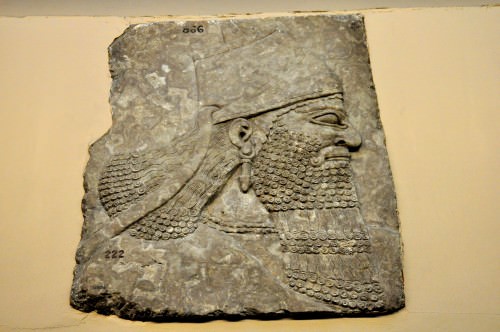
Head of Ashurnasirpal II
Having secured his empire, Ashurnasirpal II turned his attention to his capital at Ashur, which he renovated (as he also did with Nineveh and many other cities during his reign). Ashur was among the most prosperous of the Assyrian cities and had been the capital of the Assyrian Empire since the reign of Adad Nirari I (1307-1275 BCE). Once he had added his own adornments and improvements to the great city, Ashurnasirpal II now felt it was time for a change in its status. The residents of Ashur were proud of their city and of their prestige as citizens of the capital. It has been proposed by a number of scholars that Ashurnasirpal II wanted a completely new city, with a new population, that he could call his own in order to elevate his name above his predecessors and rule over a populace devoted to him, rather than to their city. This is only one theory, however, as it is not clear what exactly motivated him to move the capital from Ashur. No matter the reason, he chose the city of Kalhu and initiated his building project there.
KALHU & THE GRAND PALACE
Kalhu had been an important trading center since the 1st millennium BCE. It was located directly on a prosperous route between Ashur and Nineveh. The city had been built on the location of an earlier business community under the reign of Shalmaneser I (1274-1245 BCE) but had become dilapidated over the centuries. Ashurnasirpal II ordered the debris removed from the crumbling towers and walls and decreed a completely new city should be built, which would include a royal residence greater than that of any previous king. Ashurnasirpal II's inscriptions regarding Kalhu read, “The former city of Caleh, which Shalmaneser, king of Assyria, a prince who preceded me, had built, that city had fallen into decay and lay in ruins, it was turned into a mound and ruin heap. That city I built anew. I laid out orchards round about it, fruit and wine I offered unto Assur, my lord, I dug down to the water level. I built the wall thereof; from its foundation unto its top I built and completed it.”
The new city of Kalhu covered 360 hectares (890 acres) with a surrounding wall of 4.6 miles (7.5 kilometers). When it was completed, Ashurnasirpal II re-located an entirely new population (16,000 people) within the city's walls and took up residence in his new palace. According to the historian Karen Radner:
Kalhu's most impressive building at the time of Ashurnasirpal was certainly his new royal palace. At 200 metres long (656 feet) and 130 metres wide (426 feet), it dominated its surroundings and its position on the citadel mound led to its modern name, the Northwest Palace. It was organised around three courtyards, accommodating the state apartments, the administrative wing and the private quarters which also housed the royal women. Here, several underground tombs were uncovered in 1989, including the last resting place of Ashurnasirpal's queen Mullissu-mukannišat-Ninua, the daughter of the king's cupbearer, one of the foremost officials at court. Her rich burial goods give a vivid impression of the luxury in which the king and his entourage lived (1).
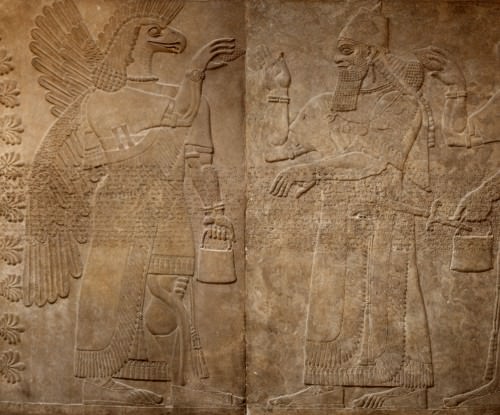
King Ashurnasirpal II
In 879 BCE, when the palace was completed and fully decorated with the reliefs lining the walls of its corridors, Ashurnasirpal II invited the surrounding population and dignitaries from other lands to celebrate. The festival lasted ten days, and his Banquet Stele records that 69,574 people attended. The menu from this celebration included, but was not limited to, 1,000 oxen, 1,000 domestic cattle and sheep, 14,000 imported and fattened sheep, 1,000 lambs, 500 game birds, 500 gazelles, 10,000 fish, 10,000 eggs, 10,000 loaves of bread, 10,000 measures of beer, and 10,000 containers of wine (Bauer, 337).When the celebration was done, he sent his guests home “in peace and joy” after allowing the dignitaries to view the reliefs in his new palace. His famous Standard Inscription told again and again of his triumphs in conquest and vividly depicted the horrible fate of those who rose against him. The inscription also let the dignitaries from his own realm, and others, know precisely who they were dealing with. He claimed the titles “great king, king of the world, the valiant hero who goes forth with the help of Assur; he who has no rival in all four quarters of the world, the exalted shepherd, the powerful torrent that none can withstand, he who has overcome all mankind, whose hand has conquered all lands and taken all the mountain ranges” (Bauer, 337). His empire stretched across the territory which today comprises western Iran, Iraq, Syria, Jordan, and part of Turkey.Through his diplomatic relationships with Babylonia and the Levant, he also had access to the resources of southern Mesopotamia and the sea ports of Phoenicia. In the understanding of the people of the Near East at that time, he really was “king of the world”.
DEATH & SUCCESSION
After a reign of 25 years, during which he completed a number of significant building projects throughout the empire, succeeded in 14 military campaigns, and established depots of food and water reserves for the people, Ashurnasirpal II died.He was succeeded by his son Shalmaneser III who reigned from 859 to 824 BCE. Shalmaneser III continued and improved upon his father's policies and expanded the empire through the kinds of military campaigns the Assyrian kings had now become famous for. He was enabled in this by the strength of the empire his father had provided. The historian Wolfram von Soden writes:
The reign of Ashurnasirpal II, marked by brutal but systematic military advances, represented the high point of the first great period of Assyrian expansion. During this king's tenure, he resettled great portions of those ethnic groups still intent on remaining autonomous, in an intensifying application of the policy the Assyrian kings had employed against rebellious subjects since the thirteenth century (56).
Shalmaneser III inherited a stronger and more capable empire than his father even had and built upon his predecessor's successes. While Ashurnasirpal II's policies may have been brutal, they were also effective in maintaining control of the population. Through his ruthless campaigns, the resettlement of populations, and his careful administration, Ashurnasirpal II consolidated the political entity that would become the greatest empire in the ancient Near East and established his name among the most memorable Assyrian kings.
LICENSE:
Article based on information obtained from these sources:with permission from the Website Ancient History Encyclopedia
Content is available under License Creative Commons: Attribution-NonCommercial-ShareAlike 3.0 Unported. CC-BY-NC-SA License